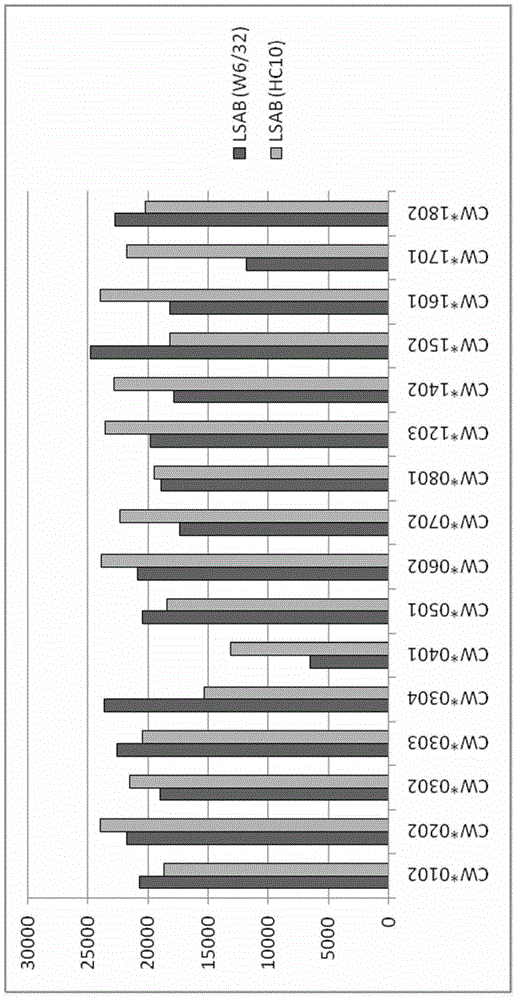Compositions and methods for detecting antibodies against natural human leukocyte antigen
A human leukocyte antigen, leukocyte antigen technology, applied in the detection of programmed cell death, receptor/cell surface antigen/cell surface determinant, compound screening, etc., can solve the problem of distinguishing between natural HLA antibodies and denatured HLA antibodies, etc.
- Summary
- Abstract
- Description
- Claims
- Application Information
AI Technical Summary
Problems solved by technology
Method used
Image
Examples
Embodiment 1
[0108] 7.1 Example 1: Preparation of Microbeads Linked to Native Class I HLA
[0109] This example provides an exemplary preparation of microbeads linked to native HLA class I ("native HLA class I microbeads"). LABScreen Single Antigen Beads (LSAB), specifically Single Antigen HLA Class I – Combi (Catalogue ID: LS1A04) was purchased from One Lambda, Inc. Untreated, LSABs contain native and denatured class I HLA bound to the bead surface.
[0110] Figures 1A-1C The reactivity of W6 / 32 and HC10 with LSAB is shown. Monoclonal antibody W6 / 32 specifically binds native class I HLA. Monoclonal antibody HC10 specifically binds to denatured class I HLA. Figures 1A-1C described for the A-locus ( Figure 1A ), B-locus ( Figure 1B ) and the C-locus ( Figure 1C) mean fluorescence intensity (MFI) of class I HLA alleles. The MFI level of the detected antibody corresponds to the level of binding of the antibody to native or denatured class I HLA. These figures show that LSAB is r...
Embodiment 2
[0115] 7.2 Example 2: Detection of natural class I HLA microbeads
[0116] This example demonstrates the high purity of exemplary microbeads prepared according to the methods described in this application. To confirm that proteolytic digestion removed denatured class I HLA, bead panels prepared according to Example 1 were incubated with W6 / 32 or HC10 to detect native or denatured class I HLA, respectively.
[0117] About 1 μl of the diluted antibody dissolved in about 100 μl of about 1X PBS was incubated with native HLA class I beads on a shaker at room temperature for about 30 minutes. Then use about 1mL Washing Solution The beads were washed three times and then incubated with about 100 μl of phycoerythrin-conjugated (PE-conjugated) goat anti-mouse secondary antibody for about 30 minutes at room temperature on a shaker. The beads were then washed three times and analyzed with a Luminex flow cytometer.
[0118] Figures 2A-2C The reactivity of W6 / 32 (specific for native ...
Embodiment 3
[0119] 7.3 Example 3: Purity of Natural Class I HLA Microbeads
[0120] This example provides the purity of several exemplary samples of native HLA class I microbeads prepared according to the methods described in this disclosure. Tables 1-3 below show the percentages of remaining denatured class I HLA in microbeads prepared according to the preparation method provided in Example 1 above and detected using the method provided in Example 2 above. Calculate the percentage of denatured class I HLA according to the formula: [HC10 MFI / (HC10 MFI+W6 / 32 MFI)]*100. Data are from 98 bead samples (5 batches).
[0121] The data in Table 1 below are the specificity of native HLA class I microsphere samples for the A-locus class I HLA alleles. The data showed that the mean percentage of denatured class I HLA was 0.81% with a standard deviation of 0.97%.
[0122] Table 1: Percentage of denatured HLA on native HLA class I beads (A-locus)
[0123] Sample ID
[0124] The data in T...
PUM
| Property | Measurement | Unit |
|---|---|---|
| diameter | aaaaa | aaaaa |
| diameter | aaaaa | aaaaa |
Abstract
Description
Claims
Application Information
 Login to View More
Login to View More - R&D
- Intellectual Property
- Life Sciences
- Materials
- Tech Scout
- Unparalleled Data Quality
- Higher Quality Content
- 60% Fewer Hallucinations
Browse by: Latest US Patents, China's latest patents, Technical Efficacy Thesaurus, Application Domain, Technology Topic, Popular Technical Reports.
© 2025 PatSnap. All rights reserved.Legal|Privacy policy|Modern Slavery Act Transparency Statement|Sitemap|About US| Contact US: help@patsnap.com



